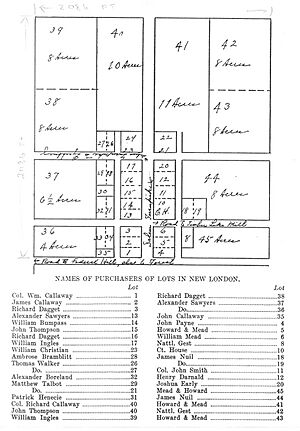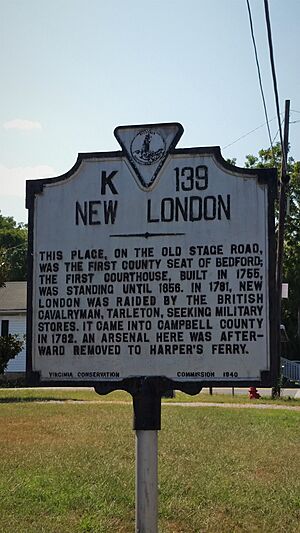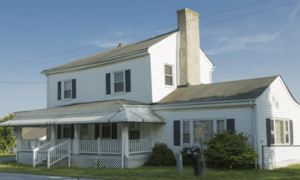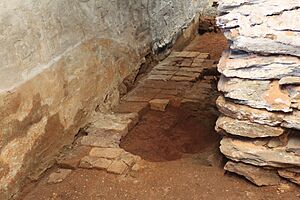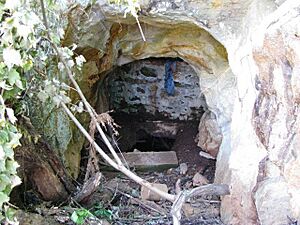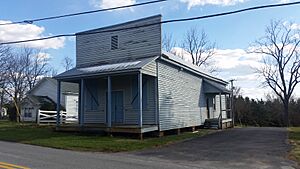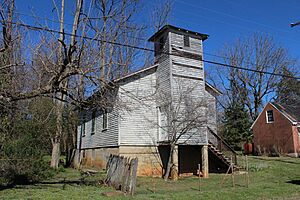New London, Virginia facts for kids
Quick facts for kids
New London, Virginia
|
|
|---|---|
| Country | United States |
| State | Virginia |
| Elevation | 863 ft (263 m) |
New London is a historic place in Campbell County, Virginia, United States. It used to be an important town, but now it's a small community without its own local government. It's about eleven miles southwest of Lynchburg, Virginia.
Back in 1754, New London became the main town, or county seat, for Bedford County. It was a busy spot because it was located where two major travel routes, the Great Wagon Road and the Wilderness Road, crossed. Many settlers heading west would stop here.
Famous people like Patrick Henry and Thomas Jefferson have connections to New London. Patrick Henry gave a famous speech in the courthouse here. Thomas Jefferson built his special home, Poplar Forest, nearby. New London also had an arsenal (a place to make and store weapons) during the American Revolutionary War.
Later, in 1781, Campbell County was created, and the county seat moved away from New London. This caused the town to become less busy. In the 1800s, people hoped to make New London popular again by promoting its natural springs. They even changed its name to Bedford Springs for a while.
Today, New London has several old buildings. Mead's Tavern is the only one left from the colonial times. Other historic buildings include the old Bedford Alum Springs Hotel and the New London Academy, which is still a school today! Many people and groups are working to protect and restore these historic places.
Contents
Exploring New London's Past
How New London Began
In 1753, a man named William Callaway gave 100 acres of land to the Virginia government. This land was used to create a new town called New London. It was chosen to be the county seat for the new Bedford County.
By 1754, a courthouse and jail were built. Land lots were sold, and new owners had to build a house within a year. Because New London was at the crossing of the Great Wagon Road and Wilderness Road, it became a very busy place for travelers and traders. This lasted until 1781, when Campbell County was formed and the county seat moved.
The John Hook Trial
The New London courthouse was famous for a trial involving John Hook. During the American Revolutionary War, John Hook, a merchant, was thought to be on the side of the British. In 1781, an army officer took two of Hook's cows for the American soldiers to eat.
After the war, Hook sued the officer for taking his property. The case lasted until 1789. Patrick Henry, a famous speaker, defended the state against John Hook. On September 19, 1789, Patrick Henry gave his well-known "beef speech" during this trial. The jury decided that Hook was owed only one cent.
About John Hook
John Hook (1745-1808) was a Scottish merchant who came to America at age 13. He learned the tobacco trade and later opened a store in New London in 1764. He became one of the most well-known merchants in Virginia.
Hook wrote that the area around New London was growing very fast. In 1770, he married Elizabeth Smith, and they had six children.
During the Revolutionary War, some people thought Hook was loyal to the British. In 1777, a group of people forced him to sign a paper saying he was loyal to America.
John Hook's old business papers are kept at Duke University. They help us understand how people bought and sold things in colonial America.
New London in the 1800s
By the early 1800s, New London was not as important because the county seat had moved. In 1813, some people tried to create a new county with New London at its center, but it didn't happen.
Even so, New London still had many visitors because it was on a main road. In 1816, Andrew Jackson, a future president, stayed in town. Around 1820, the main road was improved, making travel easier and helping trade. However, when the railroad came to nearby Lynchburg in 1848, New London became less important for travel.
In the late 1870s, the town changed its name to Bedford Springs. This was because a family started selling water from a nearby natural spring for health reasons. A large health resort, The Bedford Alum Springs Hotel, opened in 1878.
Learning in New London
In the early 1800s, New London had at least two schools: the New London Academy and the Roland School for girls.
New London Academy was a very important school throughout the 1800s. Students could study many subjects and earn a diploma for each one. Even Thomas Jefferson wanted his grandson, Francis Eppes, to attend the academy. The school stayed open even during the American Civil War.
The academy used to have strong ties to a church, and church ministers were often the principals. This changed over time, and the academy became a public school in 1870. In 1879, it started allowing both boys and girls to attend.
The Roland School for girls was located in the old Mead's Tavern from 1812 to 1822. It was a "finishing school" that taught up to forty girls. It closed when the owner moved to Lynchburg.
New London's Military Past
New London's central location made it a natural place for the county militia (local soldiers) to train and gather for wars. The militia from this area fought in conflicts like the French and Indian War and the Anglo-Cherokee War.
During the French and Indian War, there was a fight near New London in 1758 between Cherokee warriors and colonists. This event made the relationship between the British and the Cherokees worse and helped start the Anglo-Cherokee War.
The Arsenal
During the American Revolutionary War, New London had an arsenal. This was where weapons and supplies were made and stored for the Virginia state militia. These supplies helped support American generals in battles.
A British officer, Banastre Tarleton, claimed he raided New London to find the arsenal. However, Thomas Jefferson said Tarleton never actually reached New London.
The arsenal was run by Virginia until 1794, when the U.S. government took it over. It helped supply weapons for the army that stopped the Whiskey Rebellion in Pennsylvania. The arsenal moved to Harper's Ferry by 1798, but New London continued to store military equipment until at least 1812. Today, people are still looking for the exact spot where the arsenal was located.
Historic Buildings in New London
Mead's Tavern
Mead's Tavern is the oldest building still standing in the Central Virginia area. It's the only building left from New London's colonial times. William Mead built this "magnificent house" in 1763.
For about 20 years, it was a tavern. Then it became a girls' school. For most of its history, it was a family home or an office. In 2012, a group called Friends of New London bought it. They sold it to Liberty University in 2015.
Archaeologists are studying Mead's Tavern. They have found clues, like the brick style, that show it was built in the 1700s. They also found signs of another building, possibly a kitchen. These studies help us learn more about the building and the people who lived there long ago.
Bedford Alum Springs Hotel
The land where the Bedford Alum Springs Hotel stands has a long history. It was once owned by Colonel James Callaway, an important person during the Revolutionary War. Because of this, some people think the Revolutionary War arsenal might have been on this property.
The hotel started as a tavern owned by Peregrine Echols. He was the first person to sell water from the nearby natural alum springs for health reasons. The hotel became known as The Bedford Alum Springs Hotel and attracted travelers seeking the benefits of the springs.
The success of the springs led the town to change its name to Bedford Springs. The original hotel building burned down in 1871. A new, larger hotel was built in 1877, but it also burned down in 1887. The hotel was rebuilt a third time, only to burn again in 1902. The building standing today is the third rebuilt version. Liberty University bought the historic site in 2018 and plans to study it further.
W.W. Driskill Store
The general store in New London was built by Willis Washington Driskill in 1897. It was open until the 1930s. It also served as the local post office for a while. The current owners have restored the building, and it still looks much like it did originally. This building is also thought to be a possible location for the colonial military arsenal.
Holt-Ashwell House
This small wooden house dates back to at least the early 1800s. It was once owned by Andrew Holt, a formerly enslaved African American man. He earned enough money as a baker to buy freedom for his wife and two sons. Holt gave a small part of his land for a church to be built. The house itself was empty when it burned in 2017. The Friends of New London group now owns the property and is thinking about how to restore it.
Churches of New London
The New London Methodist Church was built in 1850. It was a stop for "circuit riding ministers" who traveled to different churches. This church is still standing and is used as an office for the Friends of New London, who are working to restore the town.
The current New London Methodist Episcopal Church South was built in 1930. It was the third church building on this spot. It was used for sixty years before closing in 1990. In 1851, Andrew Holt, a free African American man, donated the land for a church "for the special but not exclusive benefit of coloured people." The Friends of New London now own this building and are planning its restoration.
Historic Cemeteries
African American Cemetery
This cemetery dates back to the mid-to-late 1800s. It was where enslaved people and free African Americans in New London buried their loved ones. A descendant of those buried there, Deloris Nash Hicks, now helps care for the cemetery. Efforts are being made to clean up and restore this historic burial ground.
Callaway-Steptoe Cemetery
The Callaway-Steptoe Cemetery is located at Federal Hill in Forest, Virginia. Many important early settlers and their families are buried here, including Col. William Callaway. This cemetery was also the site of a small battle between Union and Confederate soldiers during the American Civil War. You can still see holes in the walls from cannonball fire today.
Restoring New London's History
In 2005, local people created the Friends of New London. This group works to find and protect the town's history. In 2015, when Mead's Tavern was sold to Liberty University, a partnership began. This partnership allows students to help with the restoration and learn from the process.
In 2017, the Friends of New London gained three more buildings: the African American Methodist Church, the New London Methodist Church (which is now their office), and the Holt-Ashwell house. All these buildings are being studied and restored.
In August 2018, Liberty University also bought the Bedford Alum Springs Hotel.



